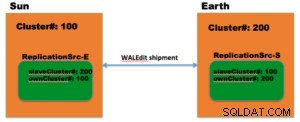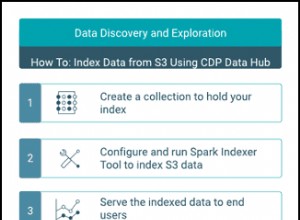Di seguito è riportato un semplice esempio per darti un'idea di quanto sia facile utilizzare alcune delle strutture dati avanzate di Redis, in questo caso Redis Lists:Il codice sorgente completo di questo esempio è visualizzabile online
using var redisClient = new RedisClient();
//Create a 'strongly-typed' API that makes all Redis Value operations to apply against Shippers
IRedisTypedClient<Shipper> redis = redisClient.As<Shipper>();
//Redis lists implement IList<T> while Redis sets implement ICollection<T>
var currentShippers = redis.Lists["urn:shippers:current"];
var prospectiveShippers = redis.Lists["urn:shippers:prospective"];
currentShippers.Add(
new Shipper {
Id = redis.GetNextSequence(),
CompanyName = "Trains R Us",
DateCreated = DateTime.UtcNow,
ShipperType = ShipperType.Trains,
UniqueRef = Guid.NewGuid()
});
currentShippers.Add(
new Shipper {
Id = redis.GetNextSequence(),
CompanyName = "Planes R Us",
DateCreated = DateTime.UtcNow,
ShipperType = ShipperType.Planes,
UniqueRef = Guid.NewGuid()
});
var lameShipper = new Shipper {
Id = redis.GetNextSequence(),
CompanyName = "We do everything!",
DateCreated = DateTime.UtcNow,
ShipperType = ShipperType.All,
UniqueRef = Guid.NewGuid()
};
currentShippers.Add(lameShipper);
Dump("ADDED 3 SHIPPERS:", currentShippers);
currentShippers.Remove(lameShipper);
Dump("REMOVED 1:", currentShippers);
prospectiveShippers.Add(
new Shipper {
Id = redis.GetNextSequence(),
CompanyName = "Trucks R Us",
DateCreated = DateTime.UtcNow,
ShipperType = ShipperType.Automobiles,
UniqueRef = Guid.NewGuid()
});
Dump("ADDED A PROSPECTIVE SHIPPER:", prospectiveShippers);
redis.PopAndPushBetweenLists(prospectiveShippers, currentShippers);
Dump("CURRENT SHIPPERS AFTER POP n' PUSH:", currentShippers);
Dump("PROSPECTIVE SHIPPERS AFTER POP n' PUSH:", prospectiveShippers);
var poppedShipper = redis.PopFromList(currentShippers);
Dump("POPPED a SHIPPER:", poppedShipper);
Dump("CURRENT SHIPPERS AFTER POP:", currentShippers);
//reset sequence and delete all lists
redis.SetSequence(0);
redis.Remove(currentShippers, prospectiveShippers);
Dump("DELETING CURRENT AND PROSPECTIVE SHIPPERS:", currentShippers);
ESEMPIO DI USCITA:
ADDED 3 SHIPPERS:
Id:1,CompanyName:Trains R Us,ShipperType:Trains,DateCreated:2010-01-31T11:53:37.7169323Z,UniqueRef:d17c5db0415b44b2ac5da7b6ebd780f5
Id:2,CompanyName:Planes R Us,ShipperType:Planes,DateCreated:2010-01-31T11:53:37.799937Z,UniqueRef:e02a73191f4b4e7a9c44eef5b5965d06
Id:3,CompanyName:We do everything!,ShipperType:All,DateCreated:2010-01-31T11:53:37.8009371Z,UniqueRef:d0c249bbbaf84da39fc4afde1b34e332
REMOVED 1:
Id:1,CompanyName:Trains R Us,ShipperType:Trains,DateCreated:2010-01-31T11:53:37.7169323Z,UniqueRef:d17c5db0415b44b2ac5da7b6ebd780f5
Id:2,CompanyName:Planes R Us,ShipperType:Planes,DateCreated:2010-01-31T11:53:37.799937Z,UniqueRef:e02a73191f4b4e7a9c44eef5b5965d06
ADDED A PROSPECTIVE SHIPPER:
Id:4,CompanyName:Trucks R Us,ShipperType:Automobiles,DateCreated:2010-01-31T11:53:37.8539401Z,UniqueRef:67d7d4947ebc4b0ba5c4d42f5d903bec
CURRENT SHIPPERS AFTER POP n' PUSH:
Id:4,CompanyName:Trucks R Us,ShipperType:Automobiles,DateCreated:2010-01-31T11:53:37.8539401Z,UniqueRef:67d7d4947ebc4b0ba5c4d42f5d903bec
Id:1,CompanyName:Trains R Us,ShipperType:Trains,DateCreated:2010-01-31T11:53:37.7169323Z,UniqueRef:d17c5db0415b44b2ac5da7b6ebd780f5
Id:2,CompanyName:Planes R Us,ShipperType:Planes,DateCreated:2010-01-31T11:53:37.799937Z,UniqueRef:e02a73191f4b4e7a9c44eef5b5965d06
PROSPECTIVE SHIPPERS AFTER POP n' PUSH:
POPPED a SHIPPER:
Id:2,CompanyName:Planes R Us,ShipperType:Planes,DateCreated:2010-01-31T11:53:37.799937Z,UniqueRef:e02a73191f4b4e7a9c44eef5b5965d06
CURRENT SHIPPERS AFTER POP:
Id:4,CompanyName:Trucks R Us,ShipperType:Automobiles,DateCreated:2010-01-31T11:53:37.8539401Z,UniqueRef:67d7d4947ebc4b0ba5c4d42f5d903bec
Id:1,CompanyName:Trains R Us,ShipperType:Trains,DateCreated:2010-01-31T11:53:37.7169323Z,UniqueRef:d17c5db0415b44b2ac5da7b6ebd780f5
DELETING CURRENT AND PROSPECTIVE SHIPPERS:
Altri esempi sono disponibili nella [Pagina degli esempi di RedisExamples Redis] e nella suite di test completa
Velocità #
Una delle cose migliori di Redis è la velocità:è veloce.
Questo esempio di seguito archivia e ottiene l'intero database Northwind (3202 record) in meno 1,2 secondi - non l'abbiamo mai fatto così in fretta!
(Esecuzione all'interno di uno unit test VS.NET/R# su un iMac di 3 anni)
using var client = new RedisClient();
var before = DateTime.Now;
client.StoreAll(NorthwindData.Categories);
client.StoreAll(NorthwindData.Customers);
client.StoreAll(NorthwindData.Employees);
client.StoreAll(NorthwindData.Shippers);
client.StoreAll(NorthwindData.Orders);
client.StoreAll(NorthwindData.Products);
client.StoreAll(NorthwindData.OrderDetails);
client.StoreAll(NorthwindData.CustomerCustomerDemos);
client.StoreAll(NorthwindData.Regions);
client.StoreAll(NorthwindData.Territories);
client.StoreAll(NorthwindData.EmployeeTerritories);
Console.WriteLine("Took {0}ms to store the entire Northwind database ({1} records)",
(DateTime.Now - before).TotalMilliseconds, totalRecords);
before = DateTime.Now;
var categories = client.GetAll<Category>();
var customers = client.GetAll<Customer>();
var employees = client.GetAll<Employee>();
var shippers = client.GetAll<Shipper>();
var orders = client.GetAll<Order>();
var products = client.GetAll<Product>();
var orderDetails = client.GetAll<OrderDetail>();
var customerCustomerDemos = client.GetAll<CustomerCustomerDemo>();
var regions = client.GetAll<Region>();
var territories = client.GetAll<Territory>();
var employeeTerritories = client.GetAll<EmployeeTerritory>();
Console.WriteLine("Took {0}ms to get the entire Northwind database ({1} records)",
(DateTime.Now - before).TotalMilliseconds, totalRecords);
/*
== EXAMPLE OUTPUT ==
Took 1020.0583ms to store the entire Northwind database (3202 records)
Took 132.0076ms to get the entire Northwind database (3202 records)
*/
Nota:il tempo totale impiegato include un'operazione Redis aggiuntiva per ogni record per memorizzare l'ID in un set Redis per ogni tipo, nonché serializzare e deserializzare ogni record utilizzando TypeSerializer di Service Stack.
Operazioni Lex #
Sono state aggiunte le nuove operazioni sugli insiemi ordinati ZRANGEBYLEX che consentono di interrogare un insieme ordinato in modo lessicale. Una buona vetrina per questo è disponibile su autocomplete.redis.io.
Queste nuove operazioni sono disponibili come mappatura 1:1 con server redis su IRedisNativeClient :
public interface IRedisNativeClient
{
...
byte[][] ZRangeByLex(string setId, string min, string max, int? skip, int? take);
long ZLexCount(string setId, string min, string max);
long ZRemRangeByLex(string setId, string min, string max);
}
E le API più intuitive sotto IRedisClient :
public interface IRedisClient
{
...
List<string> SearchSortedSet(string setId, string start=null, string end=null);
long SearchSortedSetCount(string setId, string start=null, string end=null);
long RemoveRangeFromSortedSetBySearch(string setId, string start=null, string end=null);
}
Proprio come i matcher di versione di NuGet, Redis usa [ char per esprimere inclusività e ( char per esclusività. Dal momento che IRedisClient Le API per impostazione predefinita sono ricerche inclusive, queste due API sono le stesse:
Redis.SearchSortedSetCount("zset", "a", "c")
Redis.SearchSortedSetCount("zset", "[a", "[c")
In alternativa puoi specificare che uno o entrambi i limiti siano esclusivi utilizzando il ( prefisso, ad esempio:
Redis.SearchSortedSetCount("zset", "a", "(c")
Redis.SearchSortedSetCount("zset", "(a", "(c")
Altri esempi di API sono disponibili in LexTests.cs.
API HyperLog #
Il ramo di sviluppo del server Redis (disponibile al rilascio della v3.0) include un ingegnoso algoritmo per approssimare gli elementi unici in un set con la massima efficienza in termini di spazio e tempo. Per i dettagli su come funziona, vedere il blog del creatore di Redis Salvatore che lo spiega in modo molto dettagliato. In sostanza, ti consente di mantenere un modo efficiente per contare e unire elementi unici in un set senza dover archiviare i suoi elementi. Un semplice esempio in azione:
redis.AddToHyperLog("set1", "a", "b", "c");
redis.AddToHyperLog("set1", "c", "d");
var count = redis.CountHyperLog("set1"); //4
redis.AddToHyperLog("set2", "c", "d", "e", "f");
redis.MergeHyperLogs("mergedset", "set1", "set2");
var mergeCount = redis.CountHyperLog("mergedset"); //6
Scansione API #
Redis v2.8 ha introdotto una nuova e bellissima operazione SCAN che fornisce una strategia ottimale per attraversare un intero keyset di un'istanza redis in blocchi di dimensioni gestibili utilizzando solo un cursore lato client e senza introdurre alcuno stato del server. È un'alternativa con prestazioni più elevate e dovrebbe essere utilizzata al posto di KEYS nel codice dell'applicazione. SCAN e le relative operazioni per attraversare i membri di insiemi, insiemi ordinati e hash sono ora disponibili nel client Redis nelle seguenti API:
public interface IRedisClient
{
...
IEnumerable<string> ScanAllKeys(string pattern = null, int pageSize = 1000);
IEnumerable<string> ScanAllSetItems(string setId, string pattern = null, int pageSize = 1000);
IEnumerable<KeyValuePair<string, double>> ScanAllSortedSetItems(string setId, string pattern = null, int pageSize = 1000);
IEnumerable<KeyValuePair<string, string>> ScanAllHashEntries(string hashId, string pattern = null, int pageSize = 1000);
}
public interface IRedisClientAsync
{
IAsyncEnumerable<string> ScanAllKeysAsync(string pattern = null, int pageSize, CancellationToken ct);
IAsyncEnumerable<string> ScanAllSetItemsAsync(string setId, string pattern = null, int pageSize, CancellationToken ct);
IAsyncEnumerable<KeyValuePair<string, double>> ScanAllSortedSetItemsAsync(string setId, string pattern = null, int pageSize, ct);
IAsyncEnumerable<KeyValuePair<string, string>> ScanAllHashEntriesAsync(string hashId, string pattern = null, int pageSize, ct);
}
//Low-level API
public interface IRedisNativeClient
{
...
ScanResult Scan(ulong cursor, int count = 10, string match = null);
ScanResult SScan(string setId, ulong cursor, int count = 10, string match = null);
ScanResult ZScan(string setId, ulong cursor, int count = 10, string match = null);
ScanResult HScan(string hashId, ulong cursor, int count = 10, string match = null);
}
public interface IRedisNativeClientAsync
{
ValueTask<ScanResult> ScanAsync(ulong cursor, int count = 10, string match = null, CancellationToken ct);
ValueTask<ScanResult> SScanAsync(string setId, ulong cursor, int count = 10, string match = null, CancellationToken ct);
ValueTask<ScanResult> ZScanAsync(string setId, ulong cursor, int count = 10, string match = null, CancellationToken ct);
ValueTask<ScanResult> HScanAsync(string hashId, ulong cursor, int count = 10, string match = null, CancellationToken ct);
}
Il IRedisClient fornisce un'API di livello superiore che astrae il cursore del client per esporre una sequenza enumerabile pigra per fornire un modo ottimale per lo streaming dei risultati scansionati che si integra perfettamente con LINQ, ad esempio:
var scanUsers = Redis.ScanAllKeys("urn:User:*");
var sampleUsers = scanUsers.Take(10000).ToList(); //Stop after retrieving 10000 user keys




